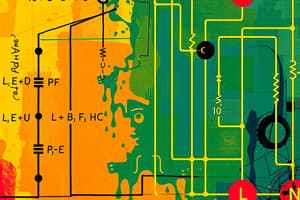Podcast
Questions and Answers
What is a characteristic of a series circuit?
What is a characteristic of a series circuit?
- There is only one path for current flow. (correct)
- Supply voltage is the same across all components.
- Total current is the sum of all branch currents.
- Total resistance is lower than the lowest individual resistance.
Which formula correctly determines the total resistance in a parallel circuit comprising two resistors?
Which formula correctly determines the total resistance in a parallel circuit comprising two resistors?
- $\frac{1}{R_T} = \frac{1}{R_1} + \frac{1}{R_2}$ (correct)
- $R_T = R_1 + R_2$
- $R_T = \frac{R_1 R_2}{R_1 + R_2}$
- $R_T = R_1 R_2$
In a parallel circuit, what is true about the supply voltage?
In a parallel circuit, what is true about the supply voltage?
- It is higher than the individual branch voltages.
- It is less than the sum of the branch voltages.
- It varies depending on the individual resistances.
- It is the same as all branch voltages. (correct)
Which of the following statements is true regarding a series-parallel circuit?
Which of the following statements is true regarding a series-parallel circuit?
How is total resistance calculated in a series circuit with two resistors?
How is total resistance calculated in a series circuit with two resistors?
What is the total resistance, RT, when R1 = 10 Ω and R2 = 20 Ω in a series circuit?
What is the total resistance, RT, when R1 = 10 Ω and R2 = 20 Ω in a series circuit?
What is the current IS in a series circuit with a supply voltage VS of 120 V and a total resistance RT of 30 Ω?
What is the current IS in a series circuit with a supply voltage VS of 120 V and a total resistance RT of 30 Ω?
If R1 is 40 Ω and IS is 0.5 A, what is the total resistance RT in the circuit?
If R1 is 40 Ω and IS is 0.5 A, what is the total resistance RT in the circuit?
What is the voltage V2 across R2 if R2 is calculated to be 80 Ω and IS is 0.5 A?
What is the voltage V2 across R2 if R2 is calculated to be 80 Ω and IS is 0.5 A?
In a series circuit with R1 = 80 Ω and R2 = 160 Ω, what is the total resistance RT?
In a series circuit with R1 = 80 Ω and R2 = 160 Ω, what is the total resistance RT?
Flashcards are hidden until you start studying
Study Notes
Types of Circuit Connections
- Three methods of connecting electrical loads: series, parallel, and series-parallel.
Series Circuit Characteristics
- Current flows through a single path: ( I_T = I_1 = I_2 ).
- Supply voltage equals the sum of individual voltages: ( V_T = V_1 + V_2 ).
- Total resistance is the sum of all individual resistances: ( R_T = R_1 + R_2 ); always higher than the highest individual resistance.
- Ohm’s Law applies: ( V_T = I_T \times R_T ).
Parallel Circuit Characteristics
- Supply voltage is the same across all branches: ( V_T = V_1 = V_2 ).
- Total current is the sum of individual branch currents: ( I_T = I_1 + I_2 ).
- Total resistance is calculated by the reciprocal of the sum of the reciprocals of individual resistances:
- ( \frac{1}{R_T} = \frac{1}{R_1} + \frac{1}{R_2} ).
- For two resistors in parallel, use: ( R_T = \frac{R_1 \times R_2}{R_1 + R_2} ); total resistance is always lower than the lowest individual resistance.
Series Circuit Example Calculations
- Example with ( R_1 = 10 , \Omega ), ( R_2 = 20 , \Omega ), ( V_S = 120 , V ):
- Total resistance: ( R_T = 10 , \Omega + 20 , \Omega = 30 , \Omega ).
- Supply current: ( I_S = \frac{V_S}{R_T} = \frac{120 , V}{30 , \Omega} = 4 , A ).
- Voltage across ( R_1 ): ( V_1 = I_1 \times R_1 = 4 , A \times 10 , \Omega = 40 , V ).
Series Circuit Practicing
- Resistors of ( 50 , \Omega ) and ( 70 , \Omega ) in series with a ( 100 , V ) supply:
- Total resistance: ( R_T = 50 , \Omega + 70 , \Omega = 120 , \Omega ).
- Supply current: ( I_S = \frac{100 , V}{120 , \Omega} \approx 0.83 , A ).
Parallel Circuit Example Calculations
- Total resistance for resistors in parallel is calculated with their reciprocal relationships.
Series-Parallel Circuit Characteristics
- Series-parallel circuits incorporate the characteristics of both series and parallel configurations.
- They offer varied paths for current, affecting voltage and resistance calculations.
Experimental Setup
- To verify series and parallel circuit characteristics, connect resistors, a voltmeter, and an ammeter appropriately for measurements.
Studying That Suits You
Use AI to generate personalized quizzes and flashcards to suit your learning preferences.



